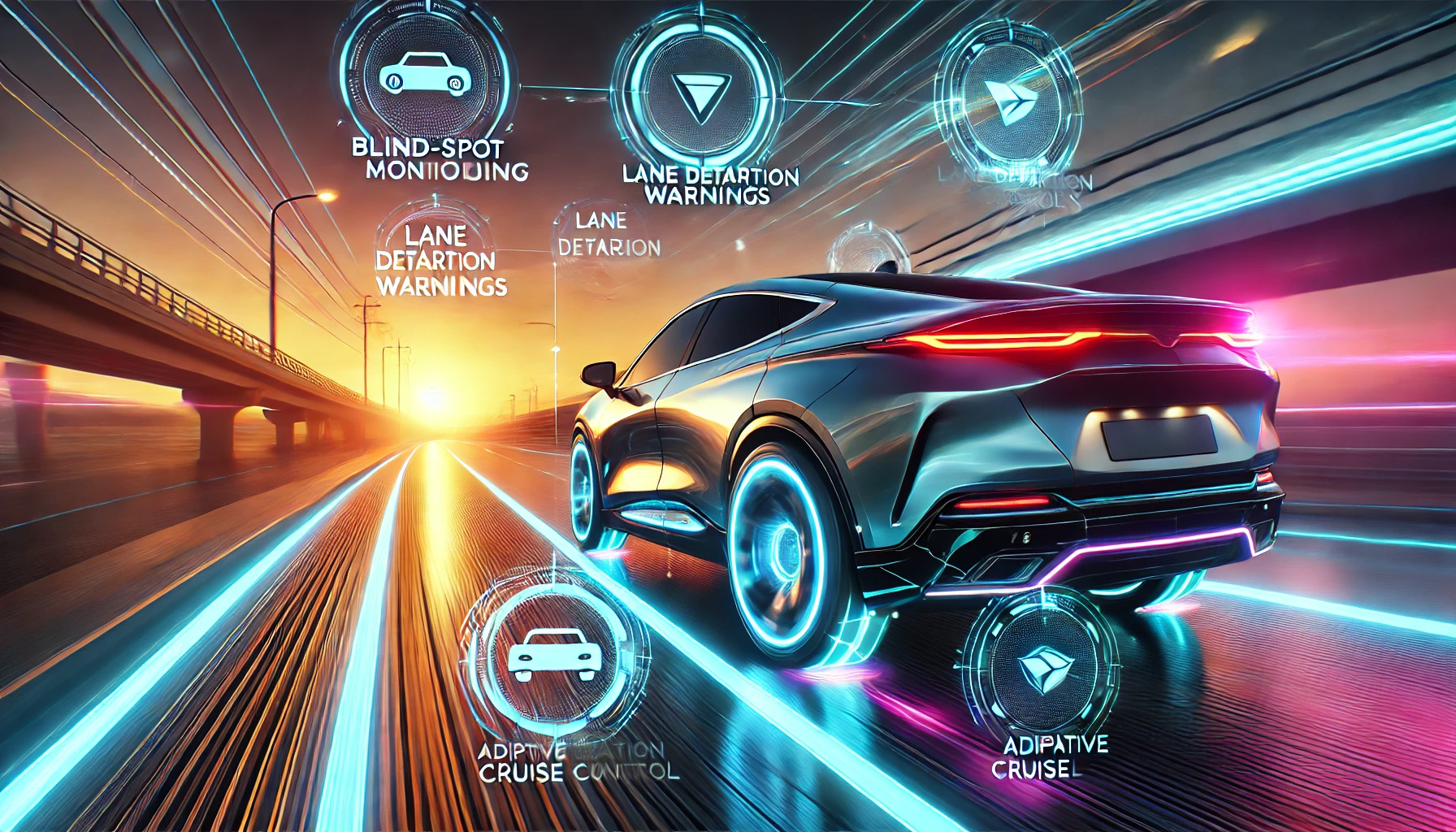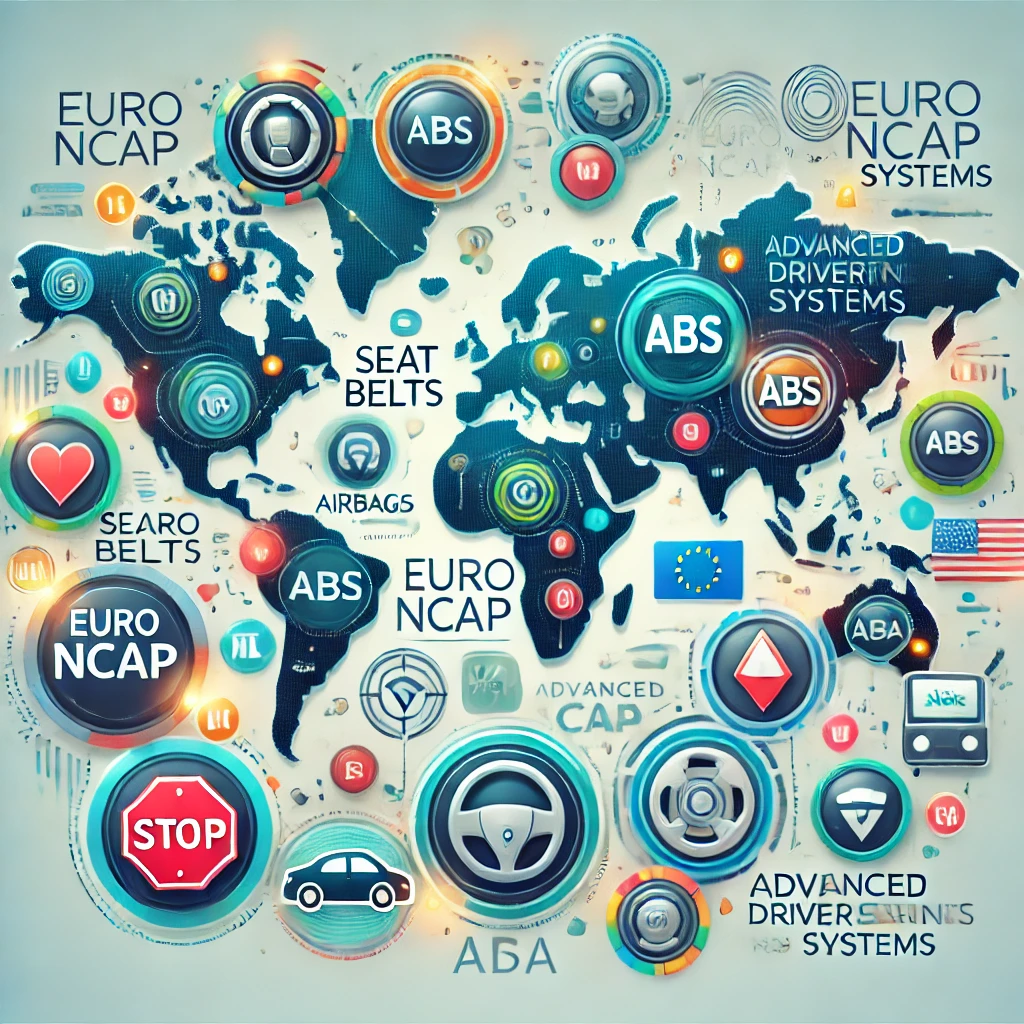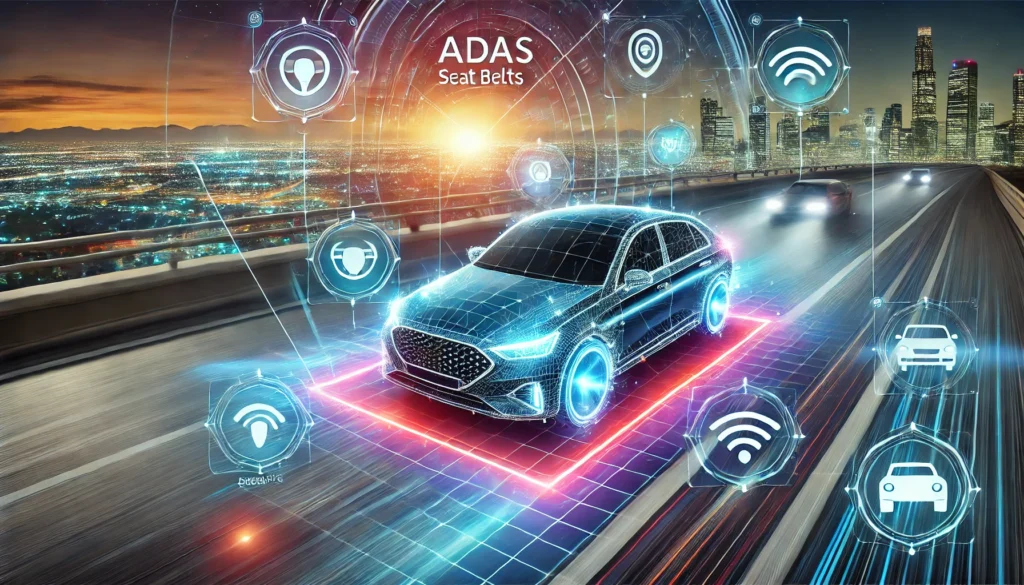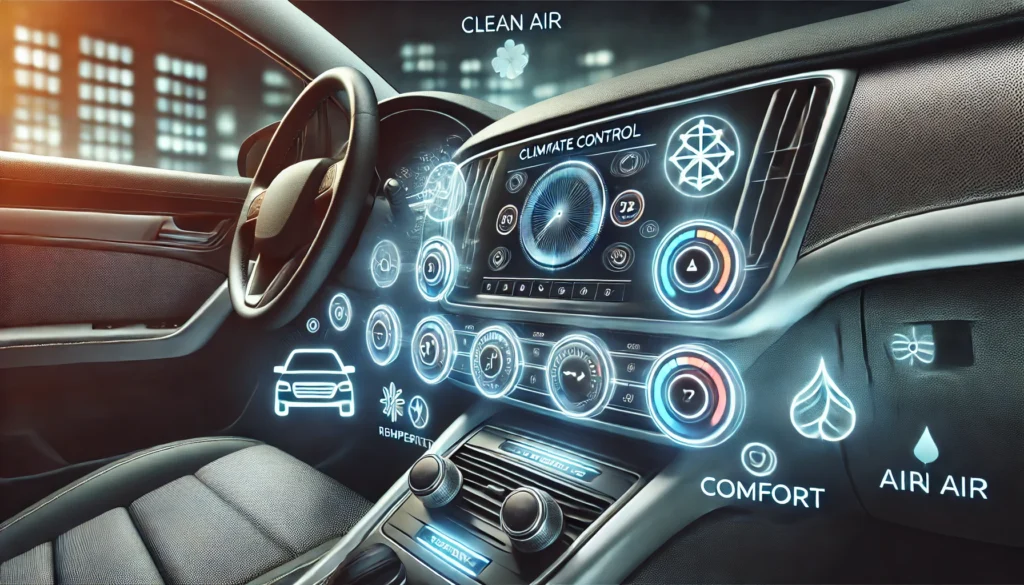Introduction – Science Behind Car Safety Features
What is the Science Behind Car Safety Features? Anyone who drives a car wants to effectively ‘get from point A to point B’ without incident, sometimes springing up. Still, they have little idea about the numerous safety features working on their behalf. Some of the car safety features, ranging from the basic seat belts to the contemporary advanced safety assistance drive systems, have been developed over time through technological innovation. They are to reduce the effect of any incidence or even eliminate it, making today’s cars far safer than those in the 70s.
Types of Car Safety Features
Passive and Active Car Safety Features
Car safety features are divided into two categories: There are two types of car safety: passive, which takes care of the occupants once an accident has occurred, and active kind, which prevents the accident from happening. The seat belt was the initial vehicle safety invention that came into the market in the 1950s, followed by airbags, ABS, and current inventions such as lane-departure warnings. All these systems combine to make roads safer for drivers and passengers.
The Role of Car Safety Features in Reducing Fatalities
The World Health Organization currently asserts that road traffic incidents lead to over one million deaths every year and leave millions of persons seriously incapacitated for life. But today’s cars with carefully designed safety features are reducing such fatalities now and then. The assessment is based on the National Highway Traffic Safety Administration. (NHTSA), one is twice protected. For example:
- Seat belts reduce fatalities for front-seat passengers by 45%
- ADAS and AEB technologies have cut accident rates by 50%.
All this has proved beyond question the use of technology in increasing the safety of roads. Having become some of the basic features, they are essential in helping people to survive road accidents and, therefore, should be considered most important, especially when buying a car.

Evolution of Science Behind Car Safety Features
From Seat Belts to Modern Autonomous Systems as Car Safety Features
The development of car safety systems has advanced from mechanical interventions to infotech-oriented ones geared toward enhancing safety and decreasing car crash rates. Automobile safety started earlier than the twentieth century; Volvo engineer Nils Bohlin invented the three-point seat belt in the fifties, which cut short injuries in collisions. Airbags were first installed as a supplemental restraint in the 1970s and have since come with side, curtain, and knee-protection airbags.
Contemporary new cars incorporate complex safety technologies such as AEB – Autonomous Emergency Braking and ADAS – Advanced Driver Assistance Systems, meaning a tendency towards avoiding accidents is beginning. This journey captures a sustained drive for enhancing road safety for all persons.
Advanced Systems Today (ADAS) and Science Behind Car Safety Features:
ADAS Continuing into the 2000s, the standards of car safety features have improved due to enhancing them with ADAS. It is these systems based on sensors, cameras, radar, and AIMs that avoid or mediate the probability of an occurrence of an accident.
- Blind Spot Monitoring
- Adaptive Cruise Control
- Lane Departure Warning and Assistance
They comprise adaptive cruise control, lane departure notice., autonomous emergency braking (AEB) systems, and modern vehicles’ most advanced car safety features. ASDS is, therefore, far more active than passive systems such as seat belts or airbags because they constantly observe the vehicle’s environment and take corrective action as needed to prevent an accident from occurring.
For example, basic systems include blind-spot monitoring that lets the driver know when other cars are in areas that are difficult to observe, and advanced systems such as adaptive cruise that automatically keeps a safe distance from the car in front of the vehicle. Some of the even more innovative systems available include Tesla’s Autopilot and GM’s Super Cruise, which helps provide:
- Semi-autonomous operation.
- Creating a foundation that could lead to the delivery of fully autonomous automobiles that could help eradicate human error.
- The primary cause for incidents.
The Importance of Regulation – Science Behind Car Safety Features
Standards and Testing
The use of car safety features that have continued to dominate the market has resulted from regulations and testing systems put in place by the government and other agencies. The National Highway Traffic Safety Administration (NHTSA) is in the Americas.
It has been very significant in standard setting and administering tests on crashes in bids to establish vehicle safety. Likewise, the European New Car Assessment Programme (Euro NCAP) has set these strict measures for testing safety standards with high measures affecting car manufacturers to address safety performance as relevant to their design.
These agencies mediate between innovation and public information and ensure that safety improvement is realized and disseminated. For instance, rules that require that such charms as ESC or rearview cameras must be designed in cars have helped to bring about massive change, and cars are much safer now than some years back.
Facts and Figures
All these innovations in the sphere of safety are highly effective. The Royal Statistical Society said that seatbelts, which were found to reduce the death chances of front-seat passengers by 45%, as estimated by the NHTSA, are among the most effective safety features that have ever been fitted in cars. Finally, when an airbag option is added to the equation, the survival rate in severe crashes is even higher. Research also reveals that ESC-equipped vehicles are associated with a 50% reduction in fatal single-vehicle accidents; the AEB technology lowers rear-end collisions by up to 50%, based on the IIHS.
Essential Car Safety Attributes and Their Functions
Automobile features can be classified as those that help to avoid an accident and those that are useful in case of an accident, the latter being called passive safety features. These compositions introduce a complete safety framework for automotive traveling, which has undergone a dramatic change. For instance, the following:
Passive Car Safety Features
These are safety features that give the occupants in the car a safer environment in case of an accident owing to the diminished capacity of the vehicle to cause harm to them. They all operate in the background to enable the car’s safe operation and only go active when an accident happens.
Seat Belts
Boyle brought a three-point seat belt to Volvo company in 1959, effectively serving as a safety feature. It also ensures that if an enormous force is applied due to an accident, the force is evenly distributed in the chest, pelvis, and shoulders, thereby minimizing damage.
Current car seats are equipped with pre-tensioners that pull in the belt during a crash so that the occupant stays securely in place and load limiters that release a small amount of webbing to reduce the impact force on the chest during high-speed crashes. These innovations are very good for providing restraint while improving comfort and increasing survival rates.
Airbags
Airbags are another safety device that works with seat belts to protect occupants, especially their upper body, from striking other car parts during an accident. There are several types of airbags:
-
Front Airbags: They protect the driver and the front passenger from impacting with force in a frontal impact.
-
Side Airbags: For a side impact, protection must be provided to the torso.
-
Curtain Airbags: Extend from the roof line for protection of the heads of the occupants during side impacts and a rollover.
-
Knee Airbags: Administer protection to the lower extremities during frontal accidents.
Airbags, on the other hand, have their power source affiliated with sensors that can recognize the immediacy of a stop. When activated, the squib or igniter initiates a chemical action that expands the airbag within milliseconds.
Stat: The Insurance Institute for Highway Safety says airbags have reduced the fatality rate by more than 50,000 in the United States after their inception and are crucial in vehicle safety.
Active Safety Features
Active safety features help prevent accidents by improving a driver’s control and awareness on the road. These systems use sensing and processing that adjusts the car’s response to road conditions in real time.
-
Anti-lock Braking System (ABS): ABS ensures that the wheels do not get locked during a strong braking force. It enables the driver to take control of the car and maneuver it, especially on icy surfaces, as locked wheels lead to slippage.
-
Electronic Stability Control (ESC): ESC improves vehicle stability by monitoring the car’s movement and comparing it with steering input. If the system detects a loss of traction, It applies brakes to individual wheels and cuts the fuel supply to the engine to help regain control. ESC is particularly effective in preventing skidding or rollovers, especially in slippery conditions or during sudden maneuvers.
-
Traction Control Systems (TCS): TCS prevents wheel spin during acceleration. It detects when a wheel is losing grip, such as on wet or icy roads, and cuts back the engine power or applies brake pressure to regain traction.
Stat: According to NHTSA, ESC reduces the risk of fatal single-vehicle crashes by 50%, making it one of the most important safety technologies.
Advanced Driver Assistance System (ADAS)
Automated Driver Assistance Systems are the newest protection innovation in cars as they employ sensors, cameras, and radar to evaluate the environment and support the driver to prevent adverse events.
-
Adaptive Cruise Control (ACC): Zero priority? ACC is driven by radar and cameras to keep a proper distance from the vehicle in front. It may increase and decrease the car’s speed or even stop the vehicle in case of traffic jams, thus making long distances comfortable.
-
Lane Departure Warning and Lane Keeping Assist: Lane Departure Warning is a system that alerts drivers when their vehicle goes off the lane. Suppose the driver does not observe the lane leaving or take the necessary action. In that case, LKA will gently glide the vehicle back to the correct place and assist in vanishing the Accidents coming from Fatigue or Distractions.
-
Blind Spot Detection: This system, operated by radar or cameras, detects the presence of a vehicle in blind areas and alerts the driver of the presence of a car on the side during the changing of lanes, thus preventing side impacts.
-
Autonomous Emergency Braking (AEB): AEB also immediately stops the car to protect it from hitting an object or a pedestrian in the car’s path in a way that could minimize a crash.
Stat: Cars with AEB drive recorded a 50% reduction in rear-end collisions, proving how it also enhances safety on the road.
Mainly, passive and active safety systems make up an effective safety structure where passive safety systems minimize the probability of occupant-sustained injuries in the instance of an accident, and active systems prevent any accidents from happening. These innovations help to save thousands of lives annually.
Sensors and Advancements Toward Car Safety
Contemporary technologies used in cars to ensure safety depend on sophisticated sensors, complex systems, and equipment to recognize specific threats, observe the environment, and respond immediately. Cooperative emerging technologies enhance all road and pedestrian users, drivers, and passengers. Sensors are the eye and ear of a vehicle, while AI/ML is the brain put to work to avoid road accidents.
This section provides details of the different kinds of sensors found in safety systems and how AI and ML have revolutionized the vehicle to make the automobile safer and more intelligent.
Types of Sensors
Car safety systems would not work without sensors since they supply accurate information on the environment around the car to allow it to make decisions to avoid an accident.
-
Ultrasonic Sensors for Parking Assist: These sensors emit sound waves that help detect nearby objects, providing alerts to assist with parking. These advanced systems can also park the car automatically when required in some of them.
-
Radar Sensors for Adaptive Cruise Control: Area radar sensors detect the distance and car speed in front while the car radar sensors keep a proper distance from the car in front. They can operate in any weather and should be used extensively on highways.
-
Cameras for Lane-Keeping and Object Detection: Some features include lane departure, which uses cameras to detect lines on the road to ensure that the car stays in the correct lane, or traffic sign detection to warn the driver of objects, people, and other vehicles on the road.
- Lidar in Autonomous Vehicles: Lidar pinpoints laser pulses toward developing the topographic contour mapping of the surrounding environment so that self-driving cars recognize barriers with great accuracy.
Role of AI and Machine Learning
Big changes have occurred in car safety due to the application of artificial intelligence and machine learning through data analysis and risk finding on roads.
-
AI Algorithms for Object Recognition: AI processes inputs from cameras, radar, and lidar to detect and react to an object, including a pedestrian or another car, for Active Safety systems, such as AEB.
-
Predictive Models for Accident Avoidance: The approaches developed through machine learning extrapolate risk factors from past occurrences so the car can respond, for instance, to slow down or give a warning to avoid an occurrence. Sensors and AI technologies work hand in hand to form a safety solution that should address risks while preventing them from minimizing the number of accidents on the Roads.
Enhancements in Vehicle Safety
Self-Driving Cars and V2X Communication
The unsafe driving paradox has long existed, suggesting that to drive is to be able to put oneself and everybody else in danger without exception. However, the design provides an answer to that problem. New technologies are already available or will be made available shortly, and they are expected to make the driving process safer or, in some instances, eliminate the process of driving altogether.
These developments do not simply seek to provide enhanced protective devices or better safety belts, airbags, or crumple zones. Instead, they aim to reduce the occurrence of motor vehicle accidents and to improve road safety not only for the passengers inside the vehicle but also for all road users. From self-driving cars to more complex means of integration into the city’s traffic – these innovations could change the whole outlook on transportation.
- Self-Driving Cars: Self-driving cars do not require input from a human driver; instead, they rely on sensors and artificial intelligence to drive, mainly to remove the human factor, which is responsible for more than 90% of crashes. Full autonomy is not quite here, but to be perfectly correct, systems such as Tesla’s Autopilot are already making roads safer. Tasks like ethical decisions and integration with infrastructure are still there, but the possibility of eliminating traffic fatalities through the use of the present.
- V2X Communication: V2X or Vehicle to Everything is another helpful innovation that enables vehicles and other systems extending from roadway infrastructure to pedestrians to share information and enhance understanding of the environment. As for the benefits of V2X systems, they can alert about potential dangers such as a traffic jam or a slippery road and, vice versa, manage traffic intensity.
It also increases pedestrians’ safety by making drivers aware of people in areas where those on foot may not be readily visible, leading to fewer accidents in smart cities.
Biometric Sensors for Driver Monitoring
Biometric sensors measure the cognitive and physical condition of the driver to stop the vehicle from going off the road due to fatigue or because the driver is distracted. These sensors follow eye movement, the rate of pulse, and facial activities. If hazardous conditions are revealed, the car may inform the driver or act independently, such as applying brakes to correct the situation and make the car be driven safely.
Enhanced Pedestrian Safety
In response, firms are designing cars with enhanced pedestrian safety features such as external airbags and new-generation detection systems. Pre-crash airbags on the outside of vehicles help to protect pedestrians once a crash has happened, while pedestrian detection employs artificial intelligence and sensors to find even those on foot in low light.
Such innovation, especially when incorporated with an Autonomous Emergency Braking system, assists in averting accidents and, hence, protecting life.
Global Regulation of Car Safety Features
Safety Standards Worldwide

Another cross-sectional point of the case study is that there are car safety features that should be adopted and regulated by every country because traffic fatalities are a global problem. Governments are intervening in these important technologies such as ABS and Airbags; for instance, India has begun insisting on ABS and front airbags in new cars.
From consumers’ perspective, organizations like Euro NCAP and IIHS may use crash test results and give a safety rating to some car models that influence the designs of those cars. These systems play an essential role in ensuring that vehicles are incredibly safe, thus lowering the number of fatal accidents. As a percentage of revenue, emerging markets’ safety is still lower than developed ones; however, there is a visible tendency implying a gradual growth caused by strengthening rules and customers’ preferences.
Do Car Safety Features Save Lives?
Safety Standards Worldwide
Car safety features do work, as statistics and published Research evidence indicate. The analysis of the fatality rate has revealed that the number of nations that use safety technologies like ABS, ESC, and airbags has decreased.
For instance, cars with 5-stars in Europe have reduced fatal crashes by 50%. Airbags used widely in the U.S. have saved over 50,000 lives, while ESC has reduced the risk of deadly accidents by half. Australia has also had a decline in the deaths that were caused by features such as AEB and ESC.
Real-Life Examples
For its part, airbags have diminished fatal injuries by 30% in frontal collisions. For instance, a driver can escape from a head-on collision through inflated airbags immediately after an accident. Always Avoiding a Bogey has reduced rear-end collisions by 50%. AEB enabled a vehicle to maneuver to avoid a crash, but the car detected a sudden stop.
Tips for Choosing the Safest Car
Key Factors to Consider
Another factor to consider when purchasing a car is the safety rating enlisted from auto safety organizations such as Euro NCAP and IIHS. The available options are cars with five stars from the Euro NCAP or Top Safety Pick+ from IIHS, as these models are the safest in the crash test and have many auxiliary systems on board.
Search for Standard ADAS Features
Select models with safety assist issues as the standard, such as lane-keeping assist, blind-spot monitoring, and adaptive cruise control. These systems reduce risk and accident probabilities, hence increasing safety.
Role of Crash Tests and Consumer Reviews
Reliance on places like the insurance institute for ratings: consumers should also look at crash test ratings and survivability. These are used to understand how the car works in actual conditions and the efficiency of used safety mechanisms.
Conclusion
Car safety features have come a long way in enhancing road safety to minimize deaths and injuries. Airbags, ABS, ESC systems, and ADAS systems are among the most effective in reducing the number of accidents or impacts. Due to new inventions and rigorous insurance standards, today’s built cars are safer than any in the past.
The primary safety aspects are that to be a safe car driver, it is imperative to make sure that the car you are driving has its safety ratings and has standard safety features, as well as for those to check the crash test results to ensure a safer road for everyone.
References
- National Highway Traffic Safety Administration (NHTSA).
- Insurance Institute for Highway Safety (IIHS).
- European New Car Assessment Program (Euro NCAP).
————————————————————————————————
For comprehensive insights and in-depth information, explore our curated collection of articles Click Below:
A Comprehensive Guide to Honda Accord: A Timeless Choice for 2024 Car Buyers
Case Studies of Cities Heavily Impacted by Smog from Vehicle Emissions
Enhancing Air Quality and Comfort: The Function of Climate Control Systems in Automobiles
Global Data – EV Tracking System & Emission Monitoring
Global Road Safety & Vehicle Standards_ A Complete Guide
Riding High – The Top 5 Vehicles Dominating 2024
Toyota Corolla 2024 Review – Everything You Need to Know About Features, Price, and Performance
The 15 Leading Startups Revolutionizing Autonomous Vehicles in 2024
The Evolution and Appeal of Sports Cars_ A Comprehensive Analysis
The Impact of Green Technology on the Automobile Industry
The Science Behind Car Safety Features_ How They Work
From Seatbelts to Sensors_ The Journey of Car Safety Innovations
How to Buy a Used Car_ A Step-by-Step Guide
————————————————————————————————
We are a Trusted Name in Automotive Industry & Technologies!
Our Trusted Partners
We are proud to collaborate with industry leaders to deliver exceptional value and quality to our customers:
- Auto World Japan: A trusted name in exporting high-quality Japanese vehicles worldwide.
- BE FORWARD: A global leader in selling and exporting used cars with an excellent reputation.
These partnerships allow us to bring you reliable, top-tier services and products directly.


